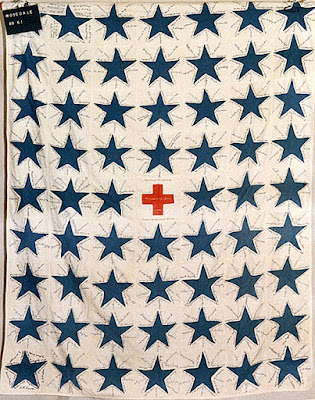Australian ladies' fair late-19th-century
Anna Quincy Waterston, when a young Bostonian, kept a diary for a year or so in the form of a letter to her traveling sister. She recorded an early ladies' fundraising fair in the spring of 1833.
Historic Newton Collection
Anna Cabot Lowell Quincy Waterston (1812-1899)
With all those Boston "Brahmin" names you know
she was wealthy and from a "good" family.
A later fair
The template for such events was set by the 1830s, a hall decorated with greenery (dangerous---could and did catch fire as it dried out) tables staffed by young women to persuade male visitors to buy. Handmade and commercial gifts and small luxuries for sale. Usually held for winter gift giving holidays.
Anna Quincy commenting on the din, the crowd and the excitement.
Illustration of a small quilt attracting a
small customer. by William Thackeray for his novel
of the 1840s Vanity Fair.
Being in their early twenties the Quincy sisters were more interested in the young men attending than in any needlework being sold at the tables. Anna does not mention embroidery, needle cases or patchwork.
This 1833 article explains the charitable cause. Thomas Handasyd Perkins made an offer to Boston's Institute for the Blind. If they could raise $50,000 by June 1, 1833 he would deed them his house on Pearl Street for a school building. New England women rallied to raise the required amount by his dealdine through ladies' fairs in Boston, Salem and Hartford. The Perkins School for the Blind was established on Post Office Square, which it outgrew 4 years later. They sold the Pearl Street house and moved to larger headquarters.
Sally Foster Otis (1770-1838)
Sally Foster Otis was the fair's organizer. Wife of former Senator Harrison Gray Otis, also a recent Boston mayor, Sally Otis is recalled as a leader in Boston's elite set.
Samuel Gridley Howe (1801-1876)
Samuel Gridley Howe, innovative educator of the visually impaired, was on the school's fundraising team.
Drama ensued when Howe's home was robbed of some Fair funds.
Fairs about this time are an early form of female commercial enterprise, made acceptable to most arbiters of social decorum by the charitable impulse. Sally Otis's May Fair for the Perkins School was an early example but U.S. fairs several preceeded it.
Above, Annette Shiell in her study of Australia's fairs discussed English origins in 1813.
Beverly Gordon in her comprehensive study of American fairs cites an 1827 fair for orphans of the Greek wars for independence in Baltimore as the earliest U.S. event.
An 1856 Massachusetts Universalist fair with the usual display of handmade goods for sale
"A large collection of articles will be offered for sale, including bonnets, comforters, quilts, stockings, shirts, children's aprons and dresses, and many other useful articles.
Further Reading:
A Woman's Wit and Whimsy: The 1833 Diary of Anna Cabot Lowell QuincyBazaars & Fair Ladies: History of the American Fundraising Fair by Beverly Gordon
Fundraising, Flirtation and Fancywork: Charity Bazaars in Nineteenth Century Australia by
Annette Shiell








.jpg)












.jpg)

































